Fecal metabolomics reveals the positive effect of ethanol extract of propolis on T2DM mice
2023-01-22ChunmeiWngHuitingZhoKiXuYliDuJinjiLiuJinfeiWngYusuoJing
Chunmei Wng, Huiting Zho, Ki Xu, Yli Du, Jinji Liu, Jinfei Wng, Yusuo Jing,*
a College of Animal Science, Shanxi Agricultural University, Taigu 030801, China
b College of Life Sciences, Shanxi Agricultural University, Taigu 030801, China
c Jilin Province Institute of Apicultural Science, Jilin 132108, China
d College of Veterinary Medicine, Shanxi Agricultural University, Taigu 030801, China
Keywords:Ethanol extract of propolis Type 2 diabetes mellitus Fecal metabolites UPLC-Q-TOF-MS Metabolomics
A B S T R A C T A large number of studies have shown that propolis has positive effects in the treatment of type 2 diabetes mellitus (T2DM). However, there are have only been a few reports that are based on an ultra-high performance liquid chromatography-quadrupole-time-of-flight-mass spectrometry (UPLC-Q-TOF-MS) analysis of the fecal metabolomics of ethanol extract of propolis (EEP) in the treatment of T2DM. The present investigation was designed to screen potential biomarkers of T2DM by the metabonomic method and to explain the possible anti-diabetes mechanism of EEP according to the changes in the biomarkers. The results showed that EEP improved the body weight (BW) of T2DM mice, lowered blood sugar levels, and significantly restored blood biochemical indicators related to T2DM, such as fasting insulin (FINS), homeostasis model assessment of insulin resistance (HOMA-IR), aspartate transaminase (AST), and alanine aminotransferase (ALT). Liver pathology showed that EEP reversed liver damage caused by T2DM. Metabolomics data identified 27 potential biomarkers in fecal samples. EEP effectively regulated the dysfunction in the metabolic pathways of glycerophospholipids, sphingolipids, riboflavins, and sterol lipids caused by T2DM. In summary, our research results revealed positive effects of EEP in the treatment of T2DM and provided potential candidate markers for further research and in the clinical treatment of T2DM.
1. Introduction
Type 2 diabetes mellitus (T2DM) is a heterogeneous disease characterized by a progressive decline in insulin action (insulin resistance (IR)), followed by the inability of β cells to compensate for IR (pancreatic β cell dysfunction) [1]. The latest Diabetes Atlas released by the International Diabetes Federation (IDF) showed that in 2019, a total of 463 million 20- to 79-year-old adults worldwide had diabetes (1 out of 11 people were diabetic), and cases are expected to reach 700.2 million by 2045 [2]. Increasing evidence suggests that liver disease and intestinal flora may be closely related to the development of metabolic diseases such as obesity, IR, and T2DM [3,4]. Studies have shown that in addition to neutral lipids (such as triglycerides (TG) or cholesterol lipids), other lipids, including diacylglycerols (DAG), ceramides, fatty acids, and their metabolites have potential biological activities and may reach excessive levels in the liver. Consequently, their accumulation may interfere with the function of liver cells, especially in the ability of liver cells to respond to changes in insulin levels [5]. Additionally, studies have found that microbial targets may have the potential to reduce IR and the incidence of common and cardiovascular diseases [6]. Because of the complex and diverse pathogenesis of T2DM, it has not been fully elucidated. Various interventions have been used to slow down the process of T2DM. Clinical medications such as metformin,sulfonylureas, and the new drugs, thiazolidinediones (TZDs), have therapeutic effects, but also have some adverse side effects on the body [7-9]. Most drugs are only used for single-channel treatment rather than multi-target therapy [10]. Therefore, there is an increasing need to develop more effective antidiabetic drugs with fewer side effects.
As a natural product, more than 300 chemical components have been isolated and identified from propolis, including polyphenols,terpenes, quinones, esters, aldehydes, ketones, and hydrocarbons, thus known as “natural purple gold” [11]. In China, the main components of propolis are polyphenols, with phenolic acids and flavonoids being the main functional components [12]. Studies have shown that flavonoids (such as chrysin, kaempferol, quercetin, and naringenin)and phenolic acids (such as caffeic acid, cinnamic acid, chlorogenic acid, caffeic acid phenethyl ester, and artepillin C) found in propolis are effective against diabetes because of their antibacterial, antiinflammatory, and immunomodulatory properties [13]. A recent study showed that propolis not only lowered blood sugar in diabetic rats,but also repaired intestinal mucosal damage and was beneficial to the intestinal flora and improved the short-chain fatty acids (SCFAs)levels in diabetic rats [14].
Metabolomics is a discipline that deals with the types, quantity changes, and interrelationships of endogenous small-molecule metabolites (molecular weight (MW) < 1 000 kDa) under the influence of internal and external factors such as disease invasion,drug intervention, and environmental changes. At present, it has been widely used in the research of disease mechanisms, the discovery of biomarkers, the evaluation and prediction of clinical efficacy, and in other fields [15-17]. The objective of this study was to identify the fecal metabolism profiles of T2DM and normal mice to screen for potential biomarkers in T2DM and explore the effects of EEP on the pathogenesis of T2DM based on an ultra-high performance liquid chromatography-quadrupole-time-of-flight-mass spectrometry(UPLC-Q-TOF-MS) metabolomics strategy. Overall, we aimed to further elucidate the pathogenesis of T2DM and provide new ideas for the clinical application of EEP.
2. Materials and methods
2.1 Chemicals and materials
Propolis was generously donated by Professor Wu Liming from the Institute of Apicultural Research, Chinese Academy of Agricultural Sciences, and the team used high-performance liquid chromatography-diode array detection/quadrupole-time-of-flightmass spectrometry (HPLC-DAD/Q-TOF-MS) analysis to determine the content of major phenolic compounds in propolis and published a paper [18]. Streptozotocin (STZ) and edible PEG-20000 were purchased from Sigma Aldrich Co. (St. Louis, MO, USA). Highfat diet (HFD, D12492, 60% kcal fat) was obtained from Research Diets (New Brunswick, NJ, USA). Standard feed (60Co irradiated maintenance feed) was purchased from SiPeiFu Biotechnology Co., Ltd. (Beijing, China). Commercial kits used to detect the total cholesterol (TC), TG, high-density lipoprotein cholesterol (HDL-C),low-density lipoprotein cholesterol (LDL-C), aspartate transaminase(AST), and alanine aminotransferase (ALT), and fasting insulin (FINS)were purchased from Zhongsheng Beikong Co., Ltd. (Beijing, China).Hematoxylin-eosin (HE) staining solution (kit) and sodium citrate buffer (0.1 mol/L, pH = 4.5, sterile solution) were obtained from Beijing Solarbio Biotechnology Co., Ltd. (Beijing, China). Anhydrous ethanol and xylene were purchased from Tianjin Zhiyuan Chemical Reagent Co., Ltd. (Wuhan, China), and 4% paraformaldehyde was purchased from Biological Technology Co., Ltd. (Wuhan, China).Methanol, formic acid, water, and acetonitrile used for HPLC analysis were purchased from CNW Technologies GmbH (Dusseldorf,Germany),L-2-chlorophenylalanine was purchased from Shanghai Hengchuang Biotechnology Co., Ltd. (Shanghai, China), and LysoPC17:0 was purchased from Avanti Polar Lipids, Inc. (Alabaster,AL, USA). All chemicals and solvents are analytically pure or chromatographic.
2.2 Preparation of EEP
Propolis was frozen at –80 °C for 24 h, weighed, and ground into powder (100 g), and then the propolis sample was dissolved in 95% (V/V) ethanol (1 L) and treated with ultrasound at 40 °C for 3 h and filtered. The filtrated residue was extracted twice again under the same conditions mentioned above. After the third extraction,the filtrated solution was combined and evaporated in the rotator at 50 °C under reduced pressure. Finally, the extract was dried in the oven to constant weight and stored at –20 °C for later use [19]. The final extract was weighed and was diluted with edible PEG-20000(3 g/10 mL) at a mass concentration of 20 g/L and stored at 4 °C until use for a maximum of 3 days.
2.3 Animal treatment
Specific pathogen-free (SPF) male BALB/c mice, 4–6 weeks old, were purchased from the Experimental Animal Center of Shanxi Medical University (Taiyuan, China). We strictly followed the international animal experiment rules and internationally recognized ethical principles of laboratory animal use and care for all mice. The mice were kept in a well-ventilated facility, with an environmental temperature of (24 ± 2) °C and relative humidity of 50%–60%. They were reared under a 12/12 h light/dark cycle and the food and drink were freely available.
After 1 week of adaptive feeding during the experiment, the control group (Con) was fed with standard feed, whereas the remaining groups were fed a HFD for four consecutive weeks of feeding. Then, the mice were fasted overnight and intraperitoneally injected with low-dose STZ (40 mg/kg, dissolved in 0.1 mol/L sodium citrate buffer) for 5 days. One week after the injection, the mice were fasted overnight, blood was collected from the tail vein, and the fasting blood glucose (FBG) level was measured with a blood glucose meter (Accu-Chek Active Blood Glucose Meter, Shanghai,China) [20]. Mice with FBG levels ≥ 11.1 mmol/L were used for this study.
Thirty T2DM mice with similar body weight (BW) and degrees of hyperglycemia were randomly divided into three groups: low-dose EEP group (EEP-L, 0.1 g/day·kg BW), high-dose EEP group (EEP-H,0.4 g/day·kg BW), and model group (T2DM). Mice in the T2DM and Con groups were fed edible PEG-20000 by gavage at 0.1 mL/10 g BW daily for 4 consecutive weeks. The body weight and FBG of the mice were monitored weekly.
2.4 Sample collection
The mice were fasted at night for 12 h. Blood was collected from the retro-orbital plexus after 4 weeks of treatment. Whole blood was centrifuged at 3 000 r/min for 15 min, and serum was collected and stored at –80 °C for further biochemical index analysis. The mice were sacrificed using carbon dioxide, and liver tissues were collected and placed in a 4% paraformaldehyde solution for HE staining. Next,fecal particles obtained from mouse cecum segment were collected in sterile cryotubes, immediately placed in liquid nitrogen, and stored at–80 °C for later use.
2.5 Biochemical analysis
A commercial kit was used to determine the levels of TC, TG,HDL-C, LDL-C, AST, and ALT in mouse serum. All the above parameters were fully automated using a Mindray BS-420 Biochemical Analyzer (Wuxi, China). Serum insulin was measured with an enzymelabeled analyzer (DR-200BS, Diatek, Wuxi, China). Homeostasis model assessment of insulin resistance (HOMA-IR) was calculated according to the following formula: fasting glucose (mmol/L) ×fasting insulin (μU/mL)/22.5.
2.6 Histopathology
Histopathology staining was carried out by Chen et al. [21].A liver tissue block with a volume of approximately 2.0 cm × 2.0 cm ×0.3 cm was immediately fixed in 4% paraformaldehyde.The specimen was dehydrated using a gradient of alcohol(75%→80%→95%→95%→100%→100%II) and xylene was transparent. After embedding in paraffin, sectioning (4 μm thick)was performed. After dewaxing and drying, the samples were stained with HE according to the manufacturer’s instructions. Liver tissue morphology was observed using a panoramic scanner (3D HISTECH,Budapest, Hungary).
2.7 Feces sample preparation
Before the UPLC-Q-TOF-MS analysis, the excreta metabolites were extracted according to the method by Ni et al. [22] with slight modifications. Thirty fecal samples (Con,n= 8; T2DM,n= 7;EEP-L,n= 8; EEP-H,n= 7) were analyzed by UPLC-Q-TOF-MS.Internal standard (0.3 mg/mLL-2-chlorophenylalanine and 0.01 mg/mL Lyso PC17:0, all with methanol) were added to an accurately weighed 60 mg sample of each stool 20 μL and 600 μL ratio of methanol:water (V:V= 4:1). The samples were pre-cooled at –20 °C for 2 min and ground at 60 Hz for 2 min. Ultrasonic extraction was performed at room temperature for 10 min, and extracts were incubated at –20 °C for 30 min. The extracts were then centrifuged at 13 000 r/min at 4 °C for 15 min. The supernatant(300 μL) was dried and redissolved in 400 μL methanol-water solution (V:V= 1:4), vortexed for 30 s, and ultrasonicated for 2 min. The samples were centrifuged at 13 000 r/min at 4 °C for 10 min, followed by extraction of the supernatant (400 μL) using a syringe and filtration using a 0.22 μm organic pinhole filter. The supernatant was then transferred to a liquid chromatography vial and stored at –80 °C until UPLC-Q-TOF-MS analysis was performed.Quality control (QC) samples were prepared by mixing all samples with the same volume of extracts. Each QC had the same volume as the sample.
2.8 UPLC-Q-TOF-MS conditions
An ExionLC UHPLC system (AB SCIEX, Framingham, MA)coupled with an AB SCIEX Triple TOF 6600 high-resolution mass spectrometer (HRMS) (AB SCIEX, Framingham, MA) was used to analyze the metabolic profile in both electrospray ionization (ESI)positive and ESI negative ion modes. An ACQUITY UPLC BEH C18column (1.7 μm, 2.1 mm × 100 mm) was used for chromatographic separation, and the LC parameters were as follows: 5 μL was injected into the system, column temperature was maintained at 45 °C,and flow rate was 0.4 mL/min. The binary gradient elution system consisted of (A) water (containing 0.1% formic acid,V:V) and (B)acetonitrile (containing 0.1% formic acid,V:V), and separation was achieved using the following gradient: 5%–20% B over 0–2 min,20%–25% B over 2–4 min, 25%–60% B over 4–9 min, 60%–100% B over 9–14 min, the composition was held at 100% B for 2 min, then 16–16.1 min, 100% to 5% B, and 16.1–18.1 min holding at 5% B. All the samples were kept at 4 °C during the analysis.
Data acquisition was performed in the full scan mode (m/zrange from 70 to 1 000) combined with the incremental dynamic analysis(IDA) mode. The parameters of mass spectrometry were as follows:ion source temperature, 550 °C (+) and 550 °C (−); ion spray voltage,5 500 V (+) and 4 500 V (−); curtain gas of 35 PSI; declustering potential (DP), 100 V (+) and −100 V (−); collision energy, 10 eV(+) and −10 eV (−); and interface heater temperature, 550 °C (+) and 600 °C (−). For the IDA, them/zrange was set to 25–1,000 and the collision energy was 30 eV.
2.9 Data processing and statistical analysis
For metabolomics analysis, the LC-MS raw data were analyzed using the Progenesis QI software (Waters Corporation, Milford, USA)with the following parameters: precursor tolerance was set at 5 × 10-6,fragment tolerance at 10 × 10-6, and retention time (RT) tolerance at 0.02 min. The internal standard detection parameters used for peak RT calibration were deselected, isotopic peaks were excluded from the analysis, and the noise elimination level was set at 10.00, with the minimum intensity set at 15% of the base peak intensity. The Excel file was obtained from the 3D data set (includingm/z, peak RT, and peak strength), and the RT-m/zpair was used as the identifier for each ion. The resulting matrix was further reduced by removing the peak of any missing value (ionic strength = 0) in more than 50% of the sample. The internal standard was used for data quality control(repeatability). Metabolites were identified using the Progenesis QI data processing software (Waters Corporation, Milford, USA),based on public databases such as http://www.hmdb.ca/, http://www.lipidmaps.org/, and a self-built database.
The positive and negative data were merged to obtain merged data, which were imported into the R ropls software package.Next, mean center (Ctr) and Pareto variance (Par) scaling, principal component analysis (PCA), and orthogonal partial least-squaresdiscriminant analysis (OPLS-DA) were conducted to visualize the metabolic alterations among experimental groups and obtain an S-plot that reflects the contribution rate between groups. In the model score diagram, the Hotelling’s T2 region displayed by the ellipse defined the 95% confidence interval of model variation. Variable importance of projection (VIP) ranked the overall contribution of each variable in the OPLS-DA model, and variables with VIP > 1 were considered relevant for group discrimination. In this study, the default 7-round cross-validation was applied with 1/7 of the samples being excluded from the mathematical model in each round to guard against overfitting. Differential metabolites were selected based on the combination of a statistically significant threshold of VIP values obtained from the OPLS-DA model andPvalues from a two-tailed Student’st-test on the normalized peak areas, with metabolites having VIP values greater than 1.0 andPvalues less than 0.05 considered as differential metabolites.
The SPSS 22.0 (International Business Machines Corporation,Armonk, New York, USA) software program was used to perform a one-way analysis of variance (ANOVA) and a least significant difference (LSD) multiple comparisons. All data are expressed as mean ± SEM, andP< 0.05 indicated a significant difference.
3. Results and discussion
3.1 Effects of EEP on body weight, blood glucose, and serum insulin
Before the EEP treatment, the body weight of the Con group was significantly higher than those of the other three groups were (P< 0.05),and there was no significant difference between the three groups(P> 0.05). At the end of the experiment, compared with the Con group,the T2DM group exhibited highly significant differences in body weight(P< 0.01), and the EEP-L and EEP-H groups were significantly different compared with the T2DM group (P< 0.05,P< 0.01) (Fig. 1A).In the extension of the diabetic process, dehydration due to the sustained high blood sugar levels, and forced decomposition of fat and protein. Consequently, accelerated energy and heat would cause the body to supplement the carbohydrates, fats, and proteins through their consumption, leading to an evident decrease in body weight [23].The results showed that after EEP treatment, the weight loss of T2DM mice could be slowed down with a dose-dependent effect. These results were consistent with that of Xue et al. [14] who studied the trend in changes in body weight of T2DM rats using poplar propolis extract.
Before the EEP treatment, the FBG of the T2DM group, EEP-L,and EEP-H groups were all greater than 11.1 mmol/L and showed the typical symptoms of “three more and one less,” indicating successful modeling of mice in the three groups, all of which were T2DM mice.The FBG levels of the three groups were not significantly different(P> 0.05), but there was a significant difference with that of the Con group (P< 0.01). During the entire experiment, the FBG levels of the Con group mice were maintained at a constant normal value.Contrary to the Con group, the FBG levels of the mice in the T2DM group were maintained at a higher blood glucose level and showed an upward trend. After the end of the trial period, compared with the T2DM group, the FBG of the EEP-L group and EEP-H were significantly lower (P< 0.01) (Fig. 1B). This result is consistent with previously reported results [20], wherein it was found that caffeic acid phenethyl ester of propolis extract could regulate blood sugar levels of non-insulin-dependent diabetes mellitus (NIDDM) mice and improved their insulin sensitivity.
After 28 days of EEP treatment, the FINS level and HOMA-IR were measured to evaluate the effects of EEP on insulin sensitivity of T2DM mice. The FINS level of the T2DM group was significantly higher than that of the Con group (P< 0.01), whereas those of the EEP-L and EEP-H treatment groups had significantly reduced FINS levels (P< 0.01), and the effect in the EEP-H group was more obvious (Fig. 1C) and tended to be normal. Subsequently, HOMAIR showed that compared with the T2DM group, the EEP-L and EEP-H groups also exhibited a significantly reduced HOMA-IR index(P< 0.01) (Fig. 1D), indicating that EEP could enhance insulin sensitivity and reduce IR.
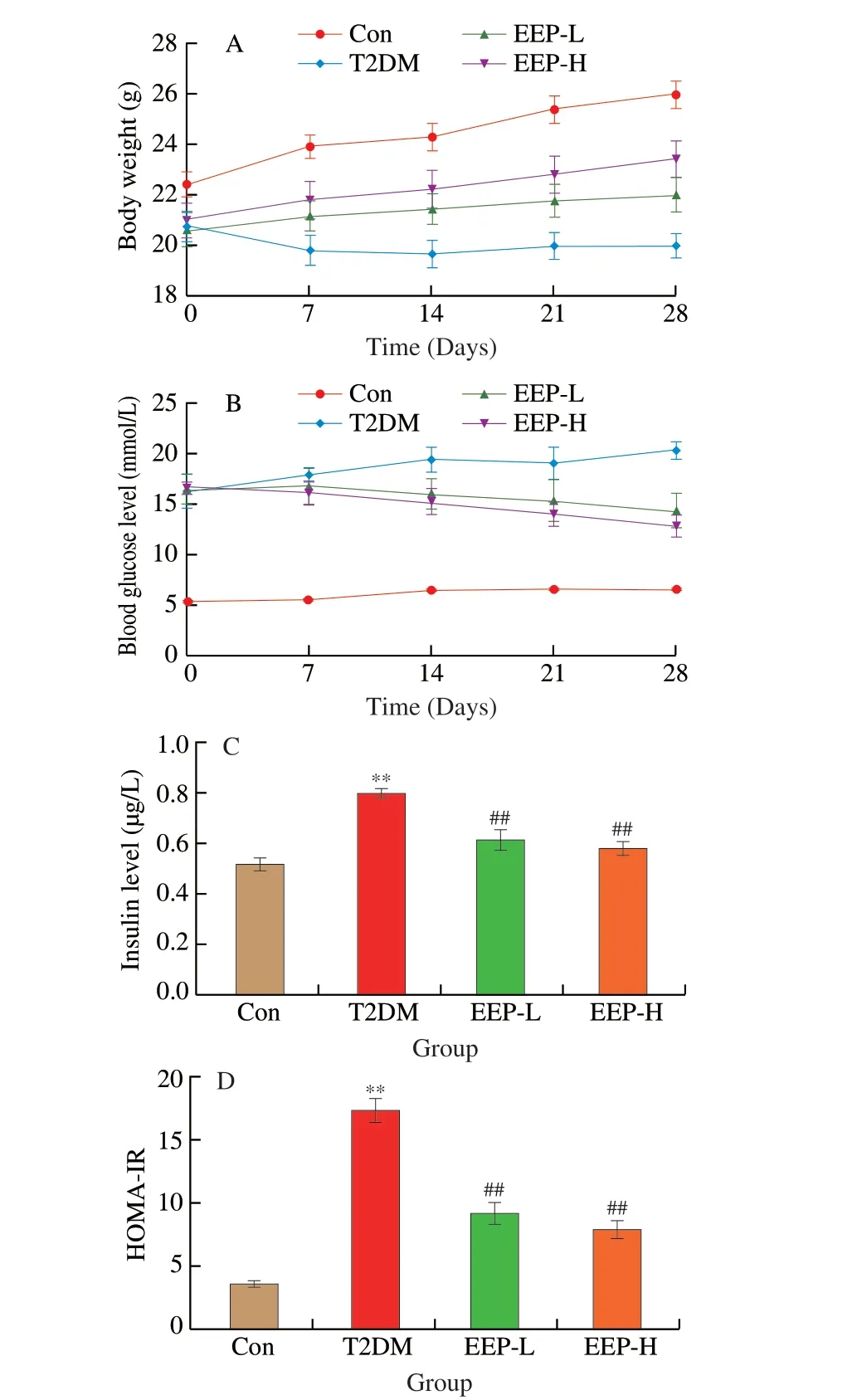
Fig. 1 At the end of the experiment, (A) body weight, (B) blood glucose level,(C) insulin level, and (D) the HOMA-IR were compared for four groups of mice. The data are presented as the mean ± SEM (n = 10). *P < 0.05, **P < 0.01,compared with that of the Con group, #P < 0.05, ##P < 0.01, compared with that of the T2DM group.
3.2 The influence of EEP on blood biochemical indices
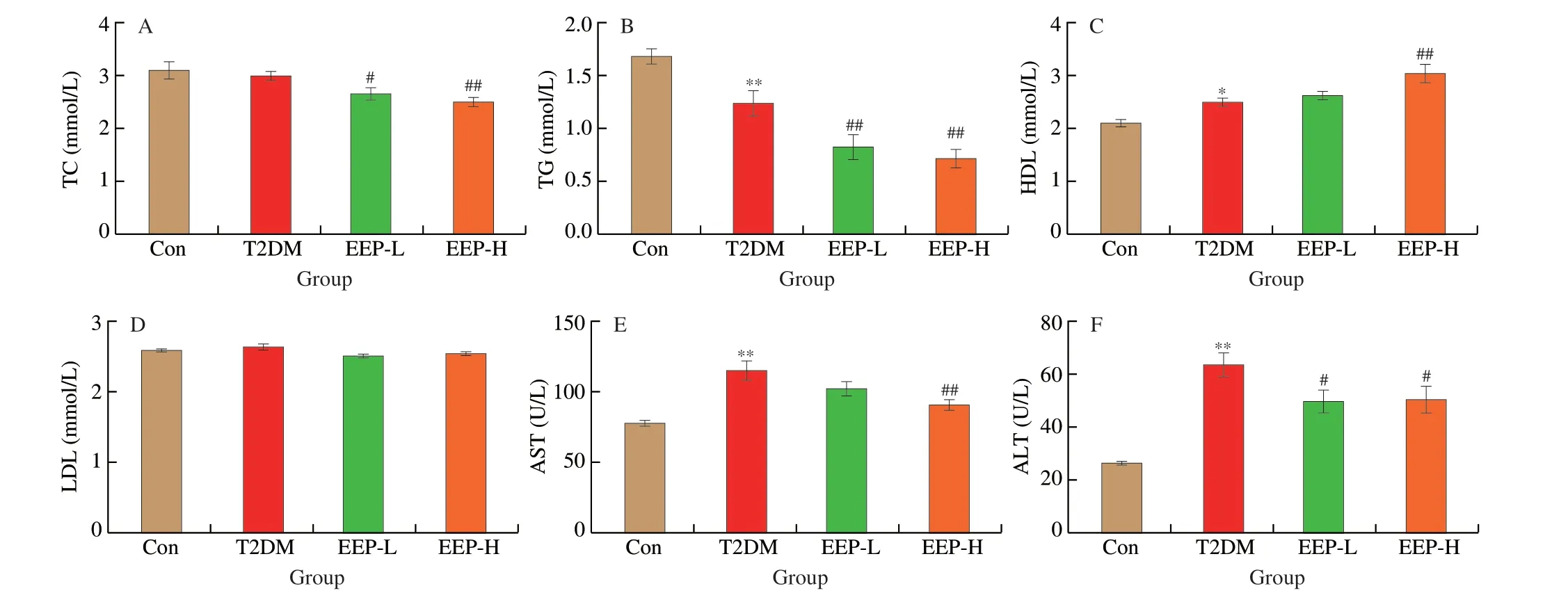
Fig. 2 Effect of EEP on the levels of (A) TC, (B) TG, (C) HDL, (D) LDL, (E) AST, (F) ALT in mice. The data are presented as the mean ± SEM (n = 10).*P < 0.05, **P < 0.01, compared with that of the Con group, #P < 0.05, ##P < 0.01, compared with that of the T2DM group.
In this experiment, we found that compared with the Con group,the TC level of the T2DM group was not significantly different(P> 0.05), but the TG level was significantly different (P< 0.05),and those of the EEP-L and EEP-H groups were significantly different compared with that of the T2DM group (P< 0.05,P< 0.01)(Figs. 2A–B). Additionally, the HDL-C level of the Con group was significantly lower than that of the T2DM group (P< 0.05).After EEP administration, the HDL-C level of the EEP-L group increased slightly, but the difference was not significant (P> 0.05),whereas the HDL-C level of the EEP-H group significantly increased(P< 0.01) (Fig. 2C). There was no significant difference in the LDL-C levels among the four groups (P> 0.05) (Fig. 2D).Fenercioglu et al. [24] found that patients with T2DM taking green tea and extracts rich in polyphenols from pomegranates could reduce LDL-C levels in the blood and increase HDL-C levels. At the same time, studies have shown that propolis is rich in phenols and can improve lipid metabolism disorders [25].
Additionally, with the prolongation of the course of T2DM, the endogenous glucose content in patients increases significantly, which damages the liver cell membrane and causes an increase in the serum aminotransferase that is released into the blood, so that the levels of AST and ALT in the blood rise. Therefore, AST and ALT are the most widely used indicators in the clinical diagnosis and differentiation of abnormal liver function [26]. Studies on the active components of propolis have shown that large amounts of flavonoids and phenols in propolis can improve liver injury by directly scavenging free radicals and enhancing the body’s antioxidant capacity [27,28]. In this experiment, compared with that of the Con group, the AST and ALT levels of the T2DM group were significantly increased (P< 0.01).After EEP treatment, the EEP-H group had significantly reduced AST and ALT levels (P< 0.01,P< 0.05). The EEP-L group also affected the AST level, but the difference was not significant (P> 0.05).However, the EEP-L group had significantly reduced ALT levels(P< 0.05) (Figs. 2E–F), which indicated that the two doses of EEP administration had different degrees of recovery of liver function and that this function may be related to its antioxidant activity.
3.3 Effect of EEP on liver injury in T2DM mice
The histopathological description of liver tissue is shown in Figs. 3A–D: Con group, HE staining shows that liver cells in the Con group are morphologically normal, the liver lobule structure is clear, the hepatocyte cords are neatly arranged, and the liver sinusoids are not significantly expanded or narrowed; there is no obvious hepatocyte degeneration and necrosis; no obvious inflammatory cell infiltration. T2DM group: Severe damage to liver cells, stenosis of the liver, swelling of the cell bodies, and light cytoplasm are observed;a small amount of lymphocyte infiltration (yellow arrow) is seen around the local vein; occasional inflammatory necrosis of liver cells(blue arrow), nucleus fragmentation, cytoplasmic eosinophilia, and other tissue morphological changes. EEP-L group: The structure of liver lobules is clearer, only some of the liver cells have mild granular degeneration (black arrow), and no obvious inflammatory cell infiltration is seen. EEP-H group: The structure of liver lobules is clearer, and tiny vacuoles (blue arrows) can be seen in the cytoplasm of some liver cells; no obvious inflammatory cell infiltration is seen.
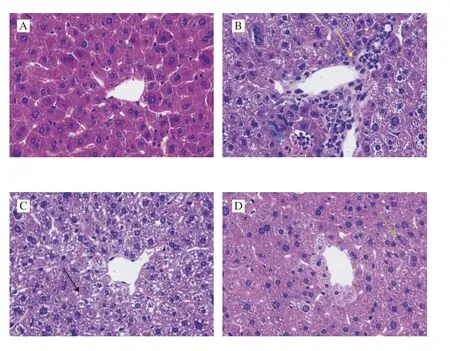
Fig. 3 The effect of EEP on liver injury in T2DM mice. (A) Con group, (B)T2DM group, (C) EEP-L group, (D) EEP-H group. HE staining; × 400.
Studies have shown that insulin resistance in T2DM patients promotes the release of free fatty acids (FFA) from adipose tissue,increases FFA in the liver, and promotes mitochondrial oxidative stress. Excessive reactive oxygen species (ROS) induces inflammation and necrosis of liver cells and activates the liver to produce more collagen and connective. Tissue growth factors accumulate extracellular matrix, and then progress to liver fibrosis and further develop into liver cirrhosis and hepatocellular carcinoma [29]. Our results demonstrated that EEP had a good recovery effect on liver tissue damage caused by T2DM, thereby reducing the occurrence of chronic liver disease and its complications.
3.4 Metabolic profile analysis
In this experiment, because there were two samples in the EEP-H group that were significantly different from other samples in the group, qualitative and quantitative analysis could not be carried out,so they were excluded. Metabonomics method based on UPLC-QTOF-MS was used to analyze changes in metabolites in the feces of four groups of mice, and multivariate statistical analysis was performed in combination with PCA and OPLS-DA to screen for potential biomarkers. PCA score plots (Figs. 4A–C) showed the overall differences between the groups (Con vs. T2DM, T2DM vs.EEP-L, and T2DM vs. EEP-H). To better distinguish inter-group metabolites, the OPLS-DA model was established to maximize the covariance between the data. As shown in Figs. 5 A-C, the OPLS-DA score diagram shows that each of the two groups of samples has good interpretation and prediction ability and has highR2YandQ2statistical values. In the OPLS-DA model, the model parameters were: T2DM/Con (Fig. 5A;R2Y(cum) = 0.989,Q2= –0.399),T2DM/EEP-L (Fig. 5B;R2Y(cum) = 0.996,Q2= –0.660), and T2DM/EEP-H (Fig. 5C;R2Y(cum) = 0.999,Q2= –0.394), and the degree of separation between the T2DM and Con groups was substantial, indicating that the T2DM model was successfully established. There was also a separation between the T2DM,EEP-L, and EEP-H groups, with the difference between the T2DM and EEP-H group being great, which indicated that propolis had a substantial influence on the fecal metabolites of T2DM. In order to prevent overfitting of the model, a seven-fold cross validation and 200 response permutation testing (RPT) were used to evaluate the quality of the model. As shown in Fig. 5 D-F, the UPLC-Q-TOF-MS analytical platform had excellent performance in validity and could be exploited in subsequently metabolomics research. According to the OPLS-DA model, the VIP was obtained, and potential biomarkers were screened using VIP > 1 andP< 0.05 as the criteria.

Fig. 4 Comparison of PCA score plots of fecal metabolism profiles of four groups of mice. (A) Con vs. T2DM; (B) T2DM vs. EEP-L; (C) T2DM vs. EEP-H.
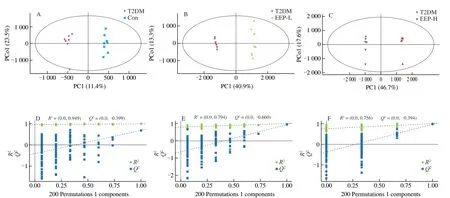
Fig. 5 Comparison of OPLS-DA scores plots and Permutation plots of fecal metabolism profiles of four groups of mice. (A) OPLS-DA: T2DM vs. Con; (B)OPLS-DA: T2DM vs. EEP-L; (C) OPLS-DA: T2DM vs. EEP-H; (D) Permutation plots: Con vs. T2DM; (E) Permutation plots: T2DM vs. EEP-L; (F) Permutation plots: T2DM vs. EEP-H.
3.5 LC-MS metabolic spectrum analysis and related pathway analysis
Based on the above differential metabolite screening criteria, 27 potential biomarkers were identified, wherein 11 metabolites were screened in anion mode and 16 metabolites were screened in cationic mode. As shown in Table 1 and Fig. 6, these metabolites are mainly involved in the metabolic pathways of sterol lipids, fatty acids,glycerophospholipids, polyketides, prenol lipids, glycerolipids, and sphingolipids. Compared with the Con group, 16 metabolites in the T2DM group were significantly decreased (P< 0.05,P< 0.01), seven metabolites were significantly increased (P< 0.05,P< 0.01), and four metabolites were at similar levels (P> 0.05). After EEP intervention,six metabolites were significantly down-regulated in the EEP-L group compared with the T2DM group (P< 0.05,P< 0.01), 12 metabolites were significantly upregulated (P< 0.05,P< 0.01), and nine metabolites were not significantly changed (P> 0.05); eight metabolites were significantly down-regulated in the EEP-H group (P< 0.01), and 19 metabolites were significantly increased (P< 0.05,P< 0.01).
PE (P-18:0), PE-Nme2 (46:3), and PI (36:1) are markers of the metabolic pathway of glycerolipids. PE (P-18:0) and PE-Nme2 (46:3)are synthetic precursors of phosphatidylcholines (PC). PE (P-18:0)is a phosphoether lipid produced by activated CDP-ethanolamine and diglyceride and can be converted to PC in the liver, with methyl provided by adenosylmethionine. PE-NME2 (46:3) is a dimethylp hosphatidylethanolamine formed by the sequential methylation of phosphatidylethanolamine that acts as part of the PC organism during synthesis. PC, also known as lecithin, is known as the “third nutrient”alongside protein and vitamin. It has the functions of emulsifying,decomposing oil, and improving blood circulation. In diabetic patients,the lack of PC decreases the function of the pancreas, resulting in insufficient insulin secretion and inability to effectively transport blood glucose to cells, leading to its increased blood level [30].PI (36:1) is a phosphatidylinositol (PI) that is a key membrane component and a second messenger of eukaryotic cells, participating in basic metabolic processes either directly or through many metabolites. Zayed et al. [31] found that the levels of PI in diabetic patients were higher than those in non-diabetic patients were. PI is the main source of arachidonic acid synthesis. Through the action of enzyme phospholipase A2, it decreases the activities of K-ATPase and Na, increases the concentration of vasodilator prostaglandin, and eventually leads to diabetes and its complications [32]. In this study,the level of PE-NME2 (46:3) (Fig. 6 (1)) decreased and the level of PI (36:1) (Fig. 6 (24)) increased in the T2DM group, but the level of PE (P-18:0) (Fig. 6 (26)) did not change significantly. The results indicated that insulin dysfunction and fatty acid metabolism disorders occurred in T2DM mice. After EEP intervention, compared with the T2DM group, the EEP-L and EEP-H groups could significantly reduce the PI (36:1) level and increase the PE-NMe2 (46:3) level in the fecal samples (P< 0.01), with the improvement effect of the high dose being more obvious.. These results indicate that EEP intervention can effectively regulate fatty acid metabolism.
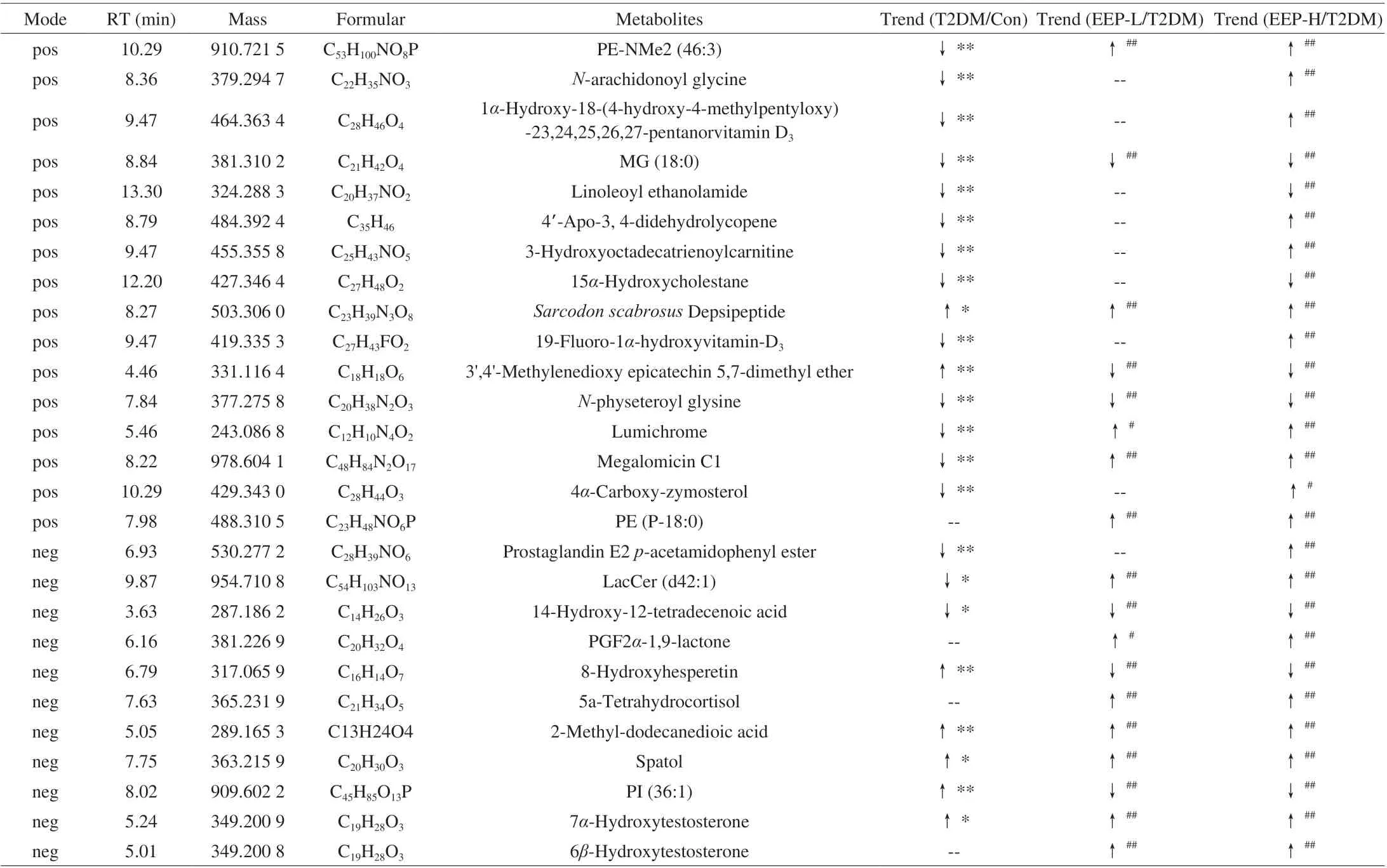
Table 1 Identification results of potential biomarkers.

Fig. 6 The relative content of 27 metabolites in fecal samples. The data are presented as the mean ± SEM (n ≥ 5). *P < 0.05, **P < 0.01, compared with that of the Con group, #P < 0.05, ##P < 0.01, compared with that of the T2DM group.
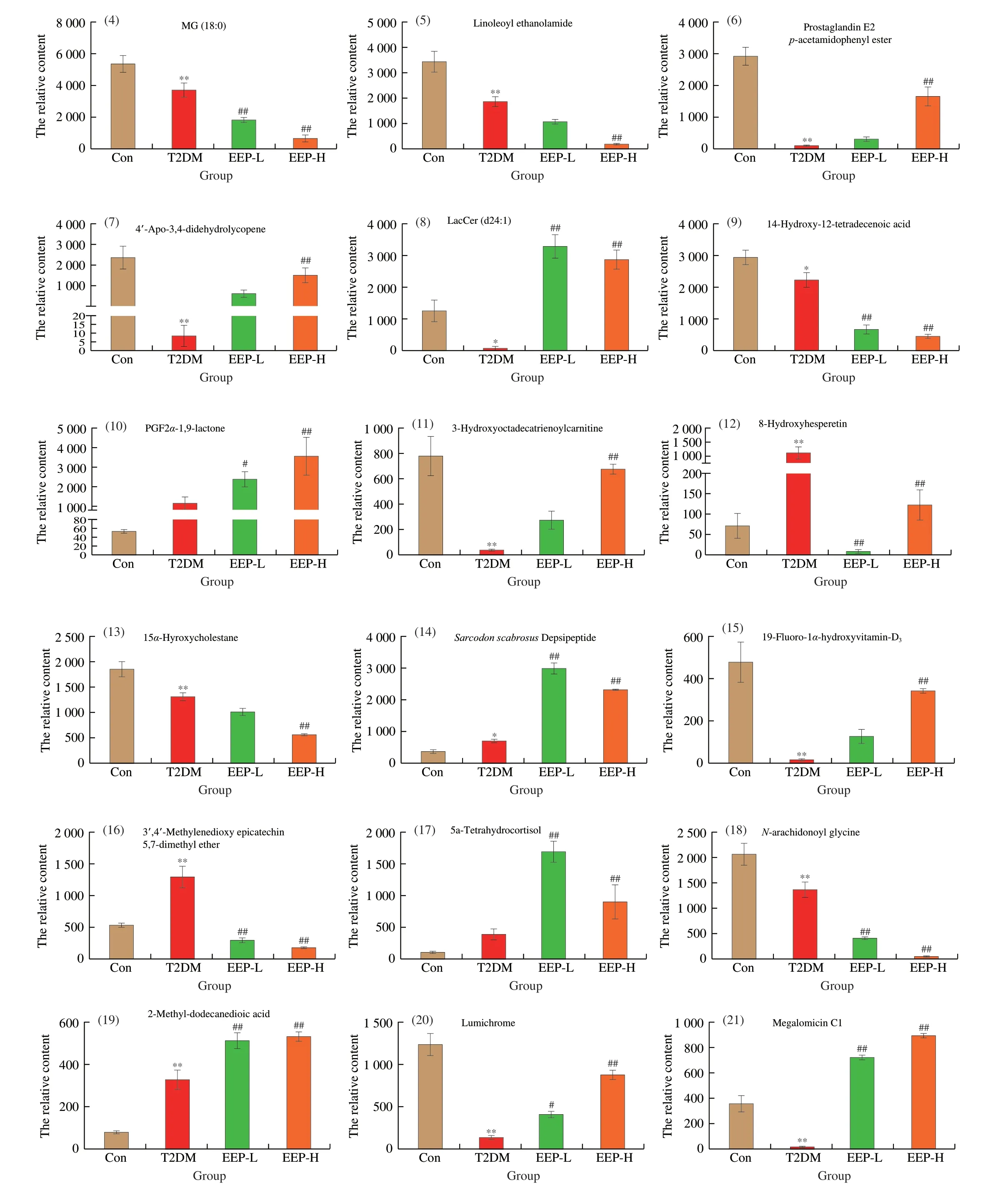
Fig. 6 (Continued)
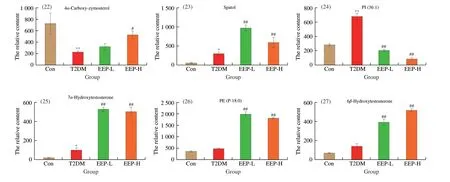
Fig. 6 (Continued)
Abnormal metabolic pathways of sphingolipids have also been observed in T2DM mice. Sphingolipids, a major component of eukaryotic cell membranes, are abundant in the central nervous system and are mainly involved in the regulation of mitosis, apoptosis,inflammatory response, glucose homeostasis, and metabolic disorders [33]. LacCer (d42:1) is an intermediate product of sphingolipid metabolism, belonging to lactose ceramide, a synthetic precursor of ganglioside, as well as a second messenger and protein receptor. Found in animal epithelial cells and nerve cells, it is expressed on neutrophils and macrophages, binds to toxins and bacteria, and is then phagocytosed and eliminated. Its dysfunction can lead to cancer and inflammation; therefore, it is essential for activating anti-inflammatory responses [34–36]. In this study, the level of LacCer (d42:1) (Fig. 6 (8)) in the T2DM group was significantly lower than that in the Con group, suggesting that the production of inflammatory cytokines may be induced in the body of T2DM mice and aggravate the occurrence and development of T2DM. After EEP intervention, the level of LacCer (d42:1) in the EEP-L and EEP-H groups increased in a dose-dependent manner, suggesting that EEP can enhance the anti-inflammatory ability of T2DM mice.
MG (18:0) is a monoacylglycerol (MG) biochemically formed by the release of fatty acids from diacylglycerol by diacylglycerol lipase or hormone-sensitive lipase. MG is the main end product of dietary fat digestion in the intestinal tract of animals by pancreatic lipase. Studies have shown that patients with colorectal cancer have significantly lower levels of MG than healthy individuals. The feces of healthy people are rich in bacterial lipase, which can metabolize dietary sources and endogenous nutrients to produce triacylglycerol,thereby increasing the final metabolites of glycerol and free fatty acids [37]. Qin et al. [38] conducted a genome-wide association analysis on T2DM patients, indicating that the increase of blood glucose leads to moderate intestinal flora imbalance, which in turn changes the flora structure and causes metabolic disorders of the body. The results of this study showed that the level of MG (18:0) in the T2DM group was significantly lower than that in the Con group(Fig. 6 (4)). It was speculated that the intestinal microflora in T2DM mice might be disturbed, which prevented lipase from decomposing glycerides and thus, reduced the level of metabolite MG (18:0). After EEP intervention, the level of MG (18:0) was lower than that of T2DM, indicating that EEP had no regulatory effect on MG (18:0).
1α-Hydroxy-18-(4-hydroxy-4-methylpentyloxy)-23,24,25,26,27-pentanorvitamin D3(Fig. 6 (3)), 19-fluoro-1alpha-hydroxyvitamin-D3(Fig. 6 (15)), 5a-tetrahydrocortisol, and 6β-hydroxytestosterone are related to steroid metabolism. Vitamin D deficiency, in addition to playing a key role in bone tissue and calcium/phosphate homeostasis,is also closely associated with several types of cancer and autoimmune or metabolic diseases such as T1DM and T2DM [39]. In STZ-induced diabetic rats, plasma calcium levels, vitamin D binding protein (DBP),and circulating vitamin D levels are reduced due to insulin deficiency in inhibiting 25 (OH) D31α-hydrogenase activity [40]. Vitamin D affects T2DM not only by regulating plasma calcium levels (regulating insulin synthesis and secretion), but also by directly acting on pancreatic beta cells to stimulate insulin secretion [41]. Vitamin D binding with the vitamin receptor (VDR) can reduce the antigenpresenting activity of macrophages to lymphocytes [42]. The results of this study showed that the levels of two vitamin D3decreased in the T2DM group, indicating pancreatic islet damage. After EEP intervention, the levels of two vitamin D3were significantly increased in the EEP-H group, indicating that EEP may affect insulin damage by regulating insulin secretion or playing an immunomotor role. Cortisol metabolite 5-tetrahydrocortisol and cortisol are insulin antagonist hormones that affect insulin reverse regulation of glucose metabolism.In patients with T2DM accompanied by a hypothalamic–pituitary–adrenal axis imbalance, cortisol can promote peripheral protein decomposition, activate the adipose decompose enzyme, make more amino acid, glycerol, and free fatty acid in the blood sugar dysplasia,which could finally cause blood sugar to rise. On the other hand, it can inhibit glucose uptake by the peripheral tissue, its utilization,causing a further rise in blood sugar [43]. 6β-Hydroxytestosterone is a testosterone metabolite derived from cytochrome P450 1B1 that can cause kidney changes in Cyp1b1-/-or castrated Cyp1b1+/+mice by changing angiotensin II. Functional impairment and end-organ damage are associated with angiotensin II-induced hypertension in male mice [44]. In this study, 5-tetrahydrocortisol (Fig. 6 (17)) and 6beta-hydroxytestosterone (Fig. 6 (27)) in mice in the T2DM group were significantly higher than those in the Con group, accumulated in the kidneys and caused renal toxicity; these changes were not reversed after EEP intervention, suggesting that EEP could not alleviate the metabolic disorders in T2DM caused by these two steroid metabolites.
Lumichrome is a photodegradation product of riboflavin in humans and mammals. It plays an important role in cell oxidation and energy metabolism. Riboflavin is the precursor of coenzymes flavin mononucleotide (FAM) and flavin adenine dinucleotide(FAD), and its deficiency is closely related to pathological conditions related to oxidative stress [45]. Previous studies have shown that the level of riboflavin in the urine of patients with T2DM is lower than normal [46]. Studies have also shown that riboflavin can inhibit the expression of TGF-β1 and PAI-1 protein in the renal tissue of diabetic rats to improve the antioxidant capacity of the body and reduce renal injury in diabetic rats [47]. The results of this study showed that compared with the Con group, the lumichrome level in the fecal metabolites in mice of the T2DM group was significantly decreased (Fig. 6 (20)), suggesting abnormal riboflavin metabolism and oxidation processes in the body. On the other hand, the level of lumichrome increased in the EEP-L and EEP-L groups, which may be due to large amounts of flavonoids and polyphenols in propolis that function as antioxidants and thus, play a role in the treatment of T2DM.
N-arachidonoyl glycine (NAGly) is a product of an enzymatic synthesis of arachidonic acid and glycine followed by degradation by fatty acid amide hydrolase; the resulting fat amino acid promotes insulin secretion; it has a structural similarity with anandamide(AEA) found mainly in the spinal cord, small intestine, pancreas,and in a variety of animal tissues [48,49]. Ikeda et al. [50] found that in pancreatic beta cells, NAGly increased the [Ca2+]i through voltage-dependent Ca2+channels (VDCC), resulting in exocytosis of insulin-containing vesicle, thereby promoting the release of insulin to maintain glucose levels in the body. This study was carried out in HFD joint induced by STZ; it is a typical pathological model of “three more and one less,” symptoms, weight loss, and “insulin secretion failure period”; NAGly level was lower in the T2DM group compared to Con (Fig. 6 (18)); following EEP intervention, it rose to a higher level, possibly by stimulating receptors on VDCC, increasing [Ca2+]i,and inhibiting the decomposition of peripheral adipose tissue to improve the body’s glucolipid metabolic disorders.
The biological effect of EEP on other potential biomarkers is unclear and requires further study. EEP may effectively regulate the disruption of the metabolic pathways of glycerolipids, sphingolipids,riboflavin, and steroids by altering the metabolic pathways of inflammation, oxidative stress, amino acids, and lipids.
4. Conclusions
Propolis is a natural medicine with a wide range of biological activities and pharmacological effects that have and has shown efficacy in the treatment of T2DM. In this study, serum biochemistry,liver morphology, and fecal metabolomics were used to detect the therapeutic effect and metabolic regulation of EEP on HFD combined with the STZ-induced T2DM mouse model. The results clarify the potential mechanism of EEP in the treatment of T2DM and provide a new direction for the treatment of T2DM. However, there are some limits to the study. The effect of propolis on T2DM was studied only from the perspective of overall metabolomics; the specific active components of propolis that affect T2DM have not been identified.Based on this study, this research group will identify the active components of EEP that affect T2DM by analyzing the chemical composition of EEP. Differential metabolites found in T2DM mice need to be validated using human patients’ samples.
Declaration of competing interest
The authors declare that they have no known competing financial interests or personal relationships that could have appeared to influence the work reported in this paper.
Acknowledgement
This work was supported by the Shanxi Proxince Higher Education Revitalization Plan “1331 Project” (J201811301).
杂志排行
食品科学与人类健康(英文)的其它文章
- Wine, beer and Chinese Baijiu in relation to cardiovascular health:the impact of moderate drinking
- Comparative analysis of physicochemical properties, ginsenosides content and α-amylase inhibitory effects in white ginseng and red ginsen
- Monitoring and identif ication of spoilage-related microorganisms in braised chicken with modif ied atmosphere packaging during refrigerated storage
- Effect of cooking processes on tilapia aroma and potential umami perception
- Formation mechanisms of ethyl acetate and organic acids in Kluyveromyces marxianus L1-1 in Chinese acid rice soup
- Volatile prof ile and multivariant analysis of Sanhuang chicken breast in combination with Chinese 5-spice blend and garam masala
